In scenarios such as cross-border e-commerce, overseas games, international live broadcasts, and overseas information content services, users often encounter a headache: slow access speed, unstable loading, and serious user loss. The root cause of these problems is often not insufficient server performance, but serious cross-border network transmission bottlenecks. Especially when mainland China accesses servers in the United States, Europe, Japan, Singapore, the Philippines, and other regions, or when accessing in the reverse direction, high packet loss rates and large delays are the norm.
The term overseas CDN acceleration dedicated line frequently appears in the vision of technical leaders, website owners, and operation and maintenance teams. But what exactly is it? Can it be accelerated by changing the line? Is its use complicated? If you still have a vague concept of this, the following content will be very important.
CDN node deployment (edge cache + back-to-source optimization)
In other words, it is not a single CDN cache function, but a combination of acceleration + transmission + stability assurance. This type of product is often called an "international network optimization solution" or an "intelligent acceleration dedicated line solution."
For example, a developer who deploys a game server in Singapore targets players in China, Vietnam, and Indonesia. Under traditional public network conditions, the average delay of accessing Singapore servers from mainland China is as high as more than 200ms, and even more than 20% of packets are lost during peak hours. After using the "Overseas CDN Acceleration Line", the delay can be controlled within 80ms by collecting traffic at the nearest node entrance + optimizing the transmission link, which greatly improves the connection quality.
How should overseas CDN acceleration lines be used?
Many people are deterred from overseas CDN dedicated lines because they think the deployment is complicated and the access threshold is high, but this is not the case. Mainstream service providers (such as Zenlayer, Tencent Cloud International Station, CDNetworks, Cloudflare Enterprise, etc.) have polished the solution into a standardized product, and the deployment path is roughly as follows:
Select the target acceleration area and source station location: The website source server is in Singapore, and users are concentrated in Shanghai, Guangzhou, and Beijing. The dedicated line service provider will allocate domestic entry nodes (such as Shanghai BGP nodes) to form a link with overseas nodes.
Configure CDN node strategy
1. Without affecting the source station architecture, configure cache strategy, page rules, intelligent back-to-source logic, etc.
2. Deploy intelligent DNS resolution or access CNAME resolution
3. The domain name accessed by the user is automatically directed to the nearest acceleration node through intelligent DNS resolution. It usually supports full network scheduling, cross-regional judgment and other capabilities.
4. Deploy encrypted tunnels (such as IPSec or SD-WAN) for dedicated line transmission
During the operation phase, the packet loss rate, jitter, and bandwidth utilization can be monitored through the visual panel, and automatic switching of backup links or black hole protection can be supported. The entire process can generally be launched within 2 to 3 hours, without business interruption, and is compatible with mainstream cloud platforms and local IDC environments.
What are the real advantages of overseas CDN dedicated lines?
1. Extreme access speed optimization: Through nearby access + backbone network dedicated line transmission + remote high-performance export nodes, the access speed can be increased by more than 3 to 5 times. Especially in mobile networks and complex operator environments, the advantages are more obvious.
2. Significantly reduce network packet loss and fluctuations: The complexity of traditional public network links leads to severe network fluctuations, while dedicated channels are centered on stability. Under the UDP/TCP protocol, they can effectively control jitter, improve connection stability, and ensure real-time services such as live broadcasts and games.
3. Secure transmission ensures business integrity: Many CDN dedicated line solutions have built-in encrypted links, anti-DDoS capabilities, and WAF security protection, which can effectively prevent security risks such as man-in-the-middle attacks and data tampering.
4. Double the ability to expand overseas business: There is no need to deploy expensive computer rooms in every country. Only through node scheduling and link optimization, low-cost global access acceleration can be achieved, greatly improving overseas user experience.

Overseas CDN acceleration dedicated lines are not a panacea, but for solving common pain points such as "slow network, jittery transmission, and poor user experience", it has become one of the most cost-effective technical paths at present. Especially at the moment when the trend of going overseas continues to grow, whoever can make users "faster" and "stable" can grab more market initiative.
Whether you are doing content distribution, SaaS applications, cross-border transactions or overseas live broadcasts, as long as you are facing "cross-border users", then overseas CDN acceleration dedicated lines are worth your careful understanding and practice.
FAQs about overseas CDN acceleration dedicated lines
Q1: What is the approximate cost of overseas CDN dedicated lines? Is it charged by traffic or bandwidth?
A1. Generally, service providers provide two modes: charging by actual traffic usage (suitable for small projects) and charging by fixed bandwidth (suitable for large and stable traffic projects). The price range ranges from a few hundred dollars to a few thousand dollars per month, depending on the region and the complexity of the node.
Q2: In addition to accelerated access, are there other application scenarios?
A2. Of course, overseas CDN dedicated lines can also be used for enterprise-level data synchronization, remote office optimization, overseas live broadcast anti-shake, SD-WAN networking and other directions, and can even be used as disaster recovery links.






